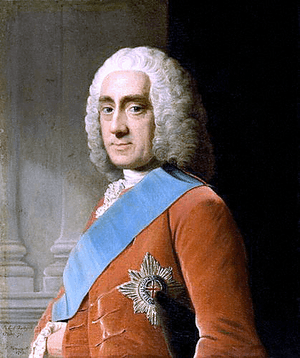Isaac Bickerstaffe facts for kids
Quick facts for kids
Isaac Bickerstaffe
|
|
|---|---|
| Born |
Isaac John Bickerstaffe
26 September 1733 Dublin, Ireland
|
| Died | after 1808 |
| Occupation | playwright, librettist |
|
Notable work
|
Thomas and Sally (1761) Love in a Village (1762) The Maide of the Mill (1765) |
Isaac Bickerstaffe (born 26 September 1733 – died after 1808) was an Irish writer who created plays and librettos. A libretto is the text used in an opera or musical work. He became famous for his comic operas, which were very popular in London.
Contents
Early Life and Military Service

Isaac John Bickerstaffe was born in Dublin, Ireland, on September 26, 1733. His father, John Bickerstaff, worked for the government. He managed sports fields like those for bowls and tennis. When his father's job was ended in 1745, he received a pension for the rest of his life.
When Isaac was young, he worked as a page for Lord Chesterfield. Lord Chesterfield was the King's representative in Ireland, called the Lord Lieutenant of Ireland. This job allowed Isaac to meet many important people in Dublin society.
In 1745, when Lord Chesterfield left his position, he helped Isaac join the army. Isaac became an Ensign in the 5th Regiment of Foot in October 1745. He was promoted to Lieutenant in 1746. His regiment was based in Kinsale, Ireland.
Moving to England and Leaving the Army
In March 1755, Isaac's regiment moved to Bristol, England. Soon after, Isaac received some money. He decided to leave the army in August and went on "half-pay." This meant he received half his usual salary.
He wanted to become a writer. However, his first work was published but not performed. He quickly faced money problems. By March 1758, he was so short of money that he joined the Marine Corps. He served as a Lieutenant in Plymouth during the Seven Years' War. This was a big war fought between many European countries. In 1763, after the war ended, he was honorably discharged from the Marines.
Becoming a Successful Playwright
Bickerstaffe first came to London in 1755 to work as a playwright. Growing up in Dublin, which was a center for arts, greatly shaped his ideas about writing. He believed that English was not suitable for singing operas, and that Italian was the best language for it. However, he later changed his mind.
Early Struggles and First Success
His first work, a long poem called Leucothoé (1756), was not successful. Even though some critics liked it, it was not turned into a musical performance. Bickerstaffe also upset David Garrick, a very famous actor and theater manager. Bickerstaffe criticized Garrick for trying to set Shakespeare's plays to music. These difficulties forced him to go back to the military.
In 1760, while still in the Marine Corps, Bickerstaffe worked with Thomas Arne. Arne was a leading British composer. They created a light opera called Thomas and Sally. This show was a huge success. It opened at the Covent Garden Theatre on November 28, 1760. The play was performed many times in London and spread across Britain and the British Empire. It was also performed in places like Dublin, Philadelphia, and Kingston, Jamaica.
More Popular Works
Bickerstaffe and Arne also worked together on Judith, a musical story performed in February 1760. Bickerstaffe went on to write many successful comedies. These were often based on plays by French writers. He also wrote many opera librettos.
In 1762, he and Arne created Love in a Village. This is considered the first English comic opera. A comic opera is a funny opera with spoken dialogue and songs.
His play The Maide of the Mill (1765), with music by Samuel Arnold, was also very popular. Bickerstaffe also wrote simpler versions of plays by other writers. Some of his other successful works include Love in the City (1767) and The Padlock (1768). The Padlock featured a character named Mungo, an early comic black role in English drama.
Later Life and Disappearance
In 1770, a newspaper incorrectly reported that Isaac Bickerstaffe had died in France.
In 1772, Bickerstaffe left for Europe. Little is known about his life after this. Some reports suggested he was in distress. However, in March 1772, it was reported that he was working on a new play called Coterie.
In early August 1772, another false report said that Bickerstaffe had died in Sussex, England. But records show he was still receiving his army half-pay in 1808. This means he lived at least until that year. He likely died soon after 1808.
Long after Bickerstaffe disappeared, his friend and colleague Charles Dibdin was often accused of using Bickerstaffe's songs in his own works.
Selected Works
- Leucothoé (1756)
- Thomas and Sally; or, The Sailor's Return (1760)
- Judith (1761)
- Love in a Village (1762)
- Daphne and Amintor (1765)
- The Maid of the Mill (1765)
- The Plain Dealer (1766)
- Love in the City (1767), later known as The Romp
- The Padlock (1768)
- The Hypocrite (1768)
- Lionel and Clarissa (1768)
- The Royal Garland (1768)
- Doctor Last in his Chariot (1769)
- The Captive (1769)
- The Recruiting Serjeant (1770)
- He Wou'd If He Cou'd; or, An Old Fool Worse Than Any (1771)
- A School for Fathers (1772)
- The Sultan; or, A Peep into the Seraglio (1775)
- The Spoil’d Child (1792)


